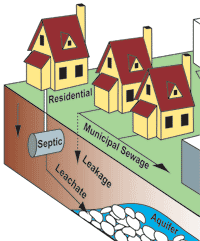
Back التأثير البيئي للأدوية ومنتجات العناية الشخصية Arabic پیامدهای زیستمحیطی داروها و محصولات مراقبت شخصی Persian 의약품 및 개인 위생용품의 환경적 영향 Korean Вплив фармацевтичних засобів та засобів особистої гігієни на довкілля Ukrainian 藥物與個人護理用品對環境的影響 Chinese
| Part of a series on |
| Pollution |
|---|
 |
The environmental effect of pharmaceuticals and personal care products (PPCPs) is being investigated since at least the 1990s. PPCPs include substances used by individuals for personal health or cosmetic reasons and the products used by agribusiness to boost growth or health of livestock. More than twenty million tons of PPCPs are produced every year.[2] The European Union has declared pharmaceutical residues with the potential of contamination of water and soil to be "priority substances".[3]
PPCPs have been detected in water bodies throughout the world. More research is needed to evaluate the risks of toxicity, persistence, and bioaccumulation, but the current state of research shows that personal care products impact the environment and other species, such as coral reefs[3][4][5] and fish.[6][7] PPCPs encompass environmental persistent pharmaceutical pollutants (EPPPs) and are one type of persistent organic pollutants. They are not removed in conventional sewage treatment plants but require a fourth treatment stage which not many plants have.[2]
In 2022, the most comprehensive study of pharmaceutical pollution of the world's rivers found that it threatens "environmental and/or human health in more than a quarter of the studied locations". It investigated 1,052 sampling sites along 258 rivers in 104 countries, representing the river pollution of 470 million people. It found that "the most contaminated sites were in low- to middle-income countries and were associated with areas with poor wastewater and waste management infrastructure and pharmaceutical manufacturing" and lists the most frequently detected and concentrated pharmaceuticals.[8][9]
- ^ "Origins and Fate of PPCPs in the Environment" (PDF). Pharmaceuticals and Personal Care Products. EPA, National Exposure Research Laboratory. March 2006.
- ^ a b Wang J, Wang S (November 2016). "Removal of pharmaceuticals and personal care products (PPCPs) from wastewater: A review". Journal of Environmental Management. 182: 620–640. doi:10.1016/j.jenvman.2016.07.049. PMID 27552641.
- ^ Shinn H (2019). "The Effects of Ultraviolet Filters and Sunscreen on Corals and Aquatic Ecosystems: Bibliography". NOAA Central Library. doi:10.25923/hhrp-xq11.
- ^ Downs CA, Kramarsky-Winter E, Segal R, Fauth J, Knutson S, Bronstein O, et al. (February 2016). "Toxicopathological Effects of the Sunscreen UV Filter, Oxybenzone (Benzophenone-3), on Coral Planulae and Cultured Primary Cells and Its Environmental Contamination in Hawaii and the U.S. Virgin Islands". Archives of Environmental Contamination and Toxicology. 70 (2): 265–88. doi:10.1007/s00244-015-0227-7. PMID 26487337. S2CID 4243494.
- ^ Downs CA, Kramarsky-Winter E, Fauth JE, Segal R, Bronstein O, Jeger R, et al. (March 2014). "Toxicological effects of the sunscreen UV filter, benzophenone-2, on planulae and in vitro cells of the coral, Stylophora pistillata". Ecotoxicology. 23 (2): 175–91. doi:10.1007/s10646-013-1161-y. PMID 24352829. S2CID 1505199.
- ^ Niemuth NJ, Klaper RD (September 2015). "Emerging wastewater contaminant metformin causes intersex and reduced fecundity in fish". Chemosphere. 135: 38–45. Bibcode:2015Chmsp.135...38N. doi:10.1016/j.chemosphere.2015.03.060. PMID 25898388.
- ^ Larsson DG, Adolfsson-Erici M, Parkkonen J, Pettersson M, Berg AH, Olsson PE, Förlin L (1999-04-01). "Ethinyloestradiol — an undesired fish contraceptive?". Aquatic Toxicology. 45 (2): 91–97. doi:10.1016/S0166-445X(98)00112-X. ISSN 0166-445X.
- ^ Cite error: The named reference
:4was invoked but never defined (see the help page). - ^ Cite error: The named reference
:7was invoked but never defined (see the help page).
© MMXXIII Rich X Search. We shall prevail. All rights reserved. Rich X Search